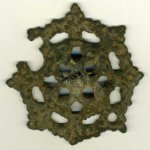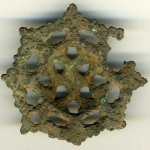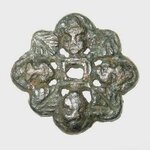Erik in NJ
Silver Member
- Oct 4, 2010
- 4,037
- 3,043
- 🥇 Banner finds
- 1
- Detector(s) used
- Minelab Explorer SE Pro & CTX-3030
- Primary Interest:
- Metal Detecting
Hi folks - been a while! Just returned from a family vacation from a former British island and found this beauty! It appears to be a bridle rosette, but my four other rosettes that I found in the US last year seem to be cast pewter/lead that is gilted. This one is appears to be a solid copper alloy (bronze) and appears to be a great deal more ornate and primitive. I can't explain the "rust-like" stains on it as it almost id'ed as silver and not at all in the iron range. It's not quite symmetrical like my others and there are possibly minute traces of what appear to be silver plating or something when viewed through a loupe. The dimensions are approx 2-1/4 x 2-1/4.
The Spanish were on this island before the Brits and I won't reveal the age of the house it was found near so as not to bias your estimate on age. Thanks for any help on this one!!
The Spanish were on this island before the Brits and I won't reveal the age of the house it was found near so as not to bias your estimate on age. Thanks for any help on this one!!




 Sorta like this one.
Sorta like this one.

 You nailed it for sure and with a very close similar (and beautiful) find
You nailed it for sure and with a very close similar (and beautiful) find 







